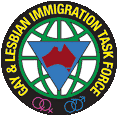The Basics
GLITF SA's primary objective is to assist same-sex partners of Australian and eligible New Zealander gays and lesbians to migrate to Australia.
Under Australia's immigration law, the applicant must show that they are in a de facto relationship (i.e genuine and continuing, at the exclusion of others) for at least 12 months prior to the application. Financial, emotional and social aspects of the relationship are assessed. As such, documentation that attests to all the different aspects of the relationship need to be presented as part of the application submission.
Upon submission of application, the applicant will receive a bridging visa while the application is being processed. If the application is approved, the bridging visa will be converted into a Temporary Residency Permit for the applicant.
If the initial application proves unsuccessful, the applicant can appeal and re-submit the application.
Amongst the information and data provided by Dept of Immigration and Border Protection (DIBP), Factsheet 35 provides an overview of the "One-Year Relationship Requirement" that is central to same-sex migration. The fact sheet is available for download on our resources page.
Cap and queue
The Migration Act 1958 (the Act), allows the Minister to 'cap' or limit the number of visas which can be granted each year in a particular visa subclass. This limit, or cap, applies only for the migration program year in which it is introduced. When a cap is reached, applicants then wait in a queue for visa grant consideration in a following year, subject to places becoming available. This means that when the number of visas set by the Minister for a visa class for the migration program year has been reached, no further visas can be granted in that program year.
Under current legislation for Family Stream Partner category visas, Partner (subclasses 309/100 and 820/801) visas are not capped.
The Process
GLITF SA's process is a Do-It-Yourself procedure - we provide information, assistance and importantly moral support to our members for them to write their own migration application. This process is significantly different from you paying a migration adviser to prepare your application. Our process means that you will have to do more work both in understanding the actual requirements and gathering the necessary documentation required. However, that translates to a substantial amount of dollars saved in fees to the migration adviser.
Please note also that if you have experienced difficulties before in migration application, or you believe that you will face substantial difficulties, or if you cannot comprehend the application requirements as outlined by GLITF SA, you may want to seek out a registered Migration Adviser to assist you. GLITF SA can help you in the right direction if you desire it.
Using GLITF SA to help you along the way;
We have provided a very basic example below of how one might go through the process of applying for a partner visa. Remember though each application is different so this is provided as a guide only
- Attend our monthly forums or workshops. Discuss with the Committee or Support Volunteers your situation and assess whether you are comfortable to go with the DIY approach.
- If you do choose to join GLITF SA as a member, there is a full or an associate membership available. Read more.
- With your membership, GLITF SA will provide a booklet titled "Partnership Migration" as a guide. Please read the information thoroughly.
- Begin to organise the required documentation for your application in preparation for a visit to our Pro Bono (free) migration agent. The visit, which we will organise for you, is recommended to allow you get a good understanding of any challenges you may face and how best to approach them. When you are meeting with the Migration Agent, be sure to bring along the as much of your application information you currently have for review and a list of any outstanding questions that you have.
- After a period of 12 months of being in a relationship and collecting evidence of that relationship, you can finalise your application. It can take anywhere between 2-6 months to put together the application together. Ensure you have the most recent forms from DIBP.
- Its a good idea to check there have been no substantial changes to the Legislation that may affect you application. You can go to our resources page for links to changes in Migration Law.
- Fill out the forms, completed all the necessary statutory declarations (for you and your partner) and compile all accompanying evidence. Remember to check and cross-check the statutory declarations for consistency in information.
- If you feel it is necessary you may need more than visit to the Agent and this can be arrange but may be at your cost.
- Lodge the application at the DIBP's Adelaide office or at the Australian Embassy if applying from outside Australia. If it required you will be advised by the officer regarding a date for interview. This interview of an hour is normally conduct for both the applicant and the sponsor. The couple are generally interviewed together.
- Alternatively you can call or visit DIBP to arrange for an interview, but you need to advise DIBP when you intend to submit your application.
Lodgement & Processing
Updated 03rd Feb, 2013
For applicants living in South Australia your Partner (Temporary) (subclass 820) visa should be lodged by post or courier to Western Australia.
Depending on where you were at the time you lodged your initial partner visa application, will determine where your Partner (Permanent) (subclass 100 or subclass 801) visa will be processed. If you lodged within Australia your Partner (Permanent) visa will be processed in Melbourne. If you lodged outside of Australia your Partner (Permanent) visa will be processed in Brisbane.
